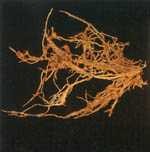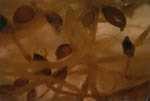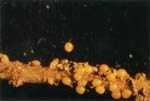Plant parasitic nematodes are small worm-like animals, usually about 1 mm in length, which live in soil and feed on plant roots, though some species attack above-ground parts. Most are of little economic importance, but a few species are serious pests and in some instances the entire crop may be lost. Since nematodes usually attack underground plant parts, there are no reliable foliar symptoms to signify that nematodes may be the major cause of poor growth and reduced tuber yields in potatoes. In roots, injury by nematodes may be detected by the presence of lesions, cysts or galls. After a few weeks, however, roots are attacked by other pathogens such as bacteria and fungi, and the original damage by nematodes may not be obvious. Consequently, nematode damage has often been attributed to other factors.
There are no estimates in Canada of yield losses in potatoes due to nematodes. However, in the United States, it is estimated that 10% of the potato crop is lost annually because of nematodes, and it is reasonable to assume that this percentage is also applicable to Canada and the Atlantic region.
Root lesion nematodes
Pratylenchus penetrans
The most important nematode parasite of potatoes in the northeastern United States and in eastern Canada is the root lesion nematode, Pratylenchus penetrans. Several other root lesion nematode species attack potatoes but are not important or have not been detected in the Atlantic region.
Root lesion nematodes invade and migrate in potato roots, though tubers are sometimes invaded when nematode populations are very high. Adult females lay eggs in roots or soil. Second stage juveniles hatch from the eggs, invade roots, and develop through the third and fourth stages to adults. Second, third, and fourth stage juveniles, as well as adult males and females are all capable of invading and migrating through roots. A life cycle takes 20 to 60 days to complete, and depends mostly on the condition of the host and on soil temperature. Maximum damage occurs in sandy soils, since these nematodes prefer this type of soil, and also because sandy soils are suited for potato culture. Above-ground symptoms caused by high populations of root lesion nematodes are sometimes falsely attributed to lack of water or nutrients.




